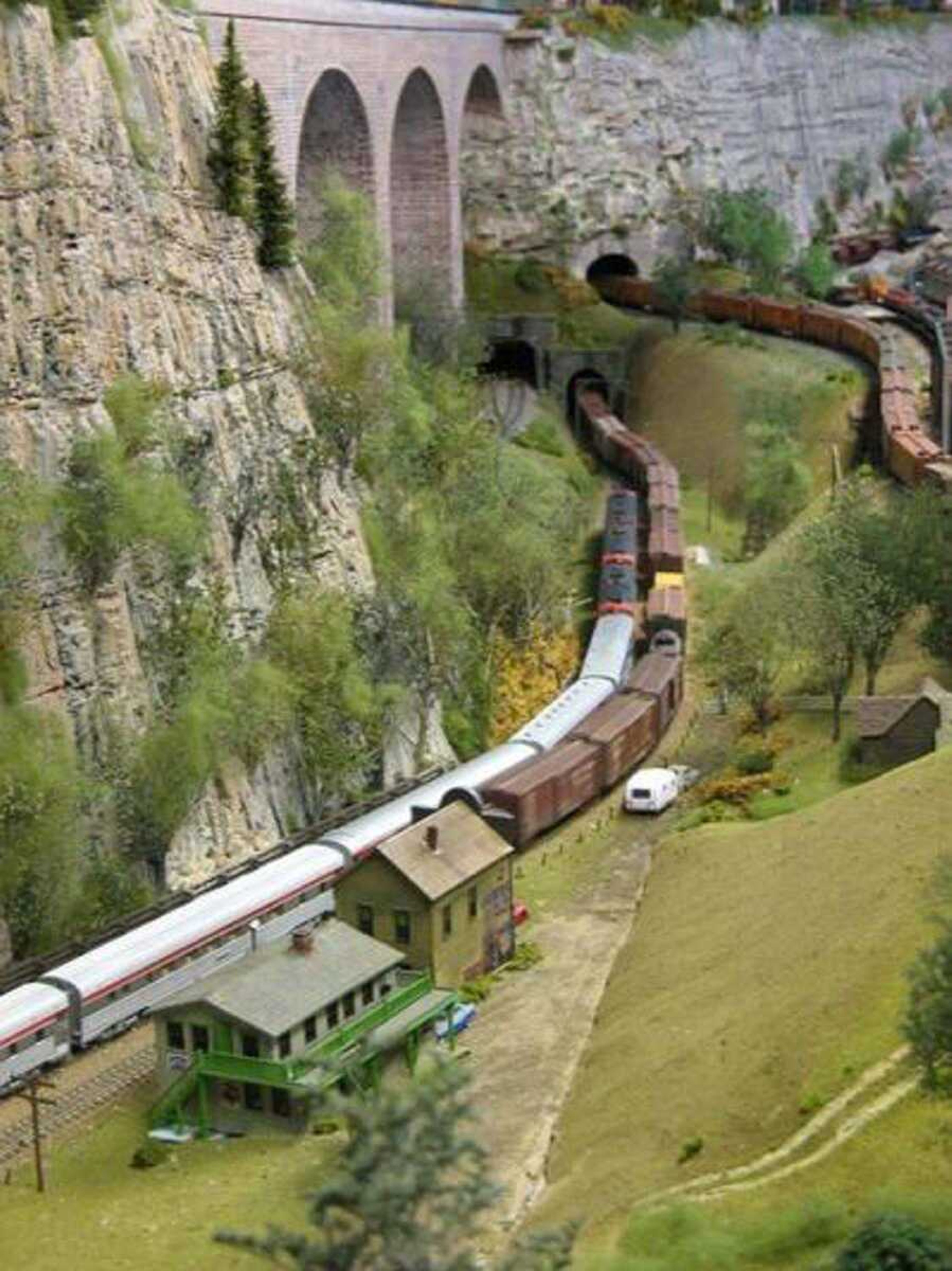DEXTER, Mo. -- Pete Parysek works hard at what he does best. He is a musician, a vocalist and an artist and instructs students from all over the area in all three disciplines. He is a member of three active musical groups and is much in demand as a performer, noted especially for his talents on the keyboard. He plays a mellow mix of contemporary jazz and classic rock, primarily in a band aptly named Saxy Jazz. Although he hardly considers his music an effort, when the day is done he plays just as hard as he works.
Parysek is the proprietor/developer/engineer/conductor of one of the most extensive train collections to be found between St. Louis and Memphis, Tenn.
"It started back in the early 1970s," Parysek said. "I always had an interest in the railroad and so I started to purchase kits and construct small scaled models of different cars."
Over a 30-year period, that initial effort has evolved into a massive engineering project, consuming nearly every available inch of the two-car garage located behind the Parysek home in Dexter.
The collection is more than a display. It is a trip back in time, to the 1950s to be exact, when milkmen delivered to the door and conductors hollered "All aboard!" at every stop along a stretch of several hundred miles.
An ice house on the edge of town lights up for a day's work. There are minuscule firefighters putting out a blaze that has nearly claimed a two-story home on the outskirts of yet another town. A grist mill seems to be in full operation in one village and outside of town a mining operation is in full swing. All the while, trains are coming and going, encircling the towns on steel tracks that are equipped with lighted crossing guards at the main streets within a village.
Passengers await the arrival of the Zephyr at the depot, dressed in their traveling clothes and holding suitcases smaller than matchboxes.
It's a meticulous, time consuming hobby and one that Parysek, who hails from San Jose, California, first took on as a musician in his early years on the road.
"You have to be retired or crazy to get into this," Parysek said, "and I'm a little bit of both."
"I found myself with a lot of time on my hands while staying in hotel rooms across the country between shows. I started purchasing the kits and I'd put together a piece. Sometime it would take hours for just one railroad car."
Until his move to Dexter in the late 1990s, Parysek and his wife, Fredrika, who is from the Bernie, Mo., area, never had the space to display his collection as it is now. The two have lived in Canada and on the west coast and have traveled extensively. Besides the musical interests, they operated and eventually retired from a successful career in real estate, something he has also pursued locally.
As the Union Pacific bypasses a Rio Grande and the faint whistle of a Santa Fe can be heard winding around a bend in the massive extension of tracks, Milwaukee and Burlington box cars, complete with hobos kicked back in a boxcar, can be seen on an elevated level of tracks in the background. Mountain tops are dusted with snow at the highest elevation and the overall flavor of the 1950s has been enhanced by Parysek having applied to nearly every surface a mix of colors, both oil and water-based, along with chalk.
"Nearly everything you see has been given a coat of the mixture," he says. "It helps in the overall presentation to make the shops, the trains, even the fire hydrants, look the part. We call it 'weathering.'"
Background terrain has been hand-carved by Parysek as well. An observer has a difficult time detecting where the molded mountains end and the actual garage walls begin, as the artist has carefully blended one to be a continuation of the other with the stroke of a paintbrush.
While some "railroaders" have resorted to the use of high-tech, using computer-aided programs to govern the train's travels, Parysek has held on to the handmade panels of numbered toggle switches and buttons to activate his collection and keep them literally "on track." All have been by his own design.
"We have little mishaps occasionally," he admits, "but for the most part I keep them under control throwing the proper switches at the proper times."
With limited space, maintenance could present a problem, but a little ingenuity solved that problem as Parysek, always the engineer, included trap doors in his display that are large enough for him to rise through from under the structure, enabling him to perform needed repairs throughout the towns and villages. Areas not accessible through the trap doors are accessed with the aid of a wand housing a tiny hook at one end that Parysek used to retrieve disabled cars or engines.
Despite the expense of building the railroad, Pete Parysek is not one who sees the need to justify his hobby, he said with a smile. "I don't ask my wife about her collection of shoes and she doesn't question the cost of my trains!"
Connect with the Southeast Missourian Newsroom:
For corrections to this story or other insights for the editor, click here. To submit a letter to the editor, click here. To learn about the Southeast Missourian’s AI Policy, click here.







